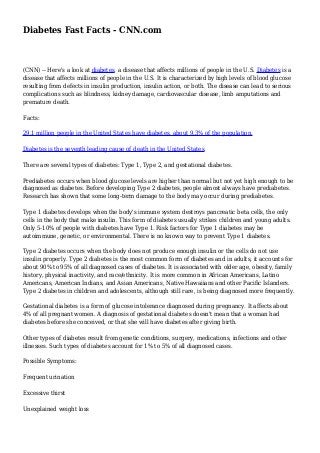Diabetes Fast Facts - CNN.com
•
1 gefällt mir•260 views
(CNN) -- Here's a look at diabetes, a disease that affects millions of people in the U.S. Diabetes i...
Melden
Teilen
Melden
Teilen
Downloaden Sie, um offline zu lesen

Empfohlen
Weitere ähnliche Inhalte
Empfohlen
Empfohlen (20)
Product Design Trends in 2024 | Teenage Engineerings

Product Design Trends in 2024 | Teenage Engineerings
How Race, Age and Gender Shape Attitudes Towards Mental Health

How Race, Age and Gender Shape Attitudes Towards Mental Health
AI Trends in Creative Operations 2024 by Artwork Flow.pdf

AI Trends in Creative Operations 2024 by Artwork Flow.pdf
Content Methodology: A Best Practices Report (Webinar)

Content Methodology: A Best Practices Report (Webinar)
How to Prepare For a Successful Job Search for 2024

How to Prepare For a Successful Job Search for 2024
Social Media Marketing Trends 2024 // The Global Indie Insights

Social Media Marketing Trends 2024 // The Global Indie Insights
Trends In Paid Search: Navigating The Digital Landscape In 2024

Trends In Paid Search: Navigating The Digital Landscape In 2024
5 Public speaking tips from TED - Visualized summary

5 Public speaking tips from TED - Visualized summary
Google's Just Not That Into You: Understanding Core Updates & Search Intent

Google's Just Not That Into You: Understanding Core Updates & Search Intent
The six step guide to practical project management

The six step guide to practical project management
Beginners Guide to TikTok for Search - Rachel Pearson - We are Tilt __ Bright...

Beginners Guide to TikTok for Search - Rachel Pearson - We are Tilt __ Bright...
Diabetes Fast Facts - CNN.com
- 1. Diabetes Fast Facts - CNN.com (CNN) -- Here's a look at diabetes, a disease that affects millions of people in the U.S. Diabetes is a disease that affects millions of people in the U.S. It is characterized by high levels of blood glucose resulting from defects in insulin production, insulin action, or both. The disease can lead to serious complications such as blindness, kidney damage, cardiovascular disease, limb amputations and premature death. Facts: 29.1 million people in the United States have diabetes, about 9.3% of the population. Diabetes is the seventh leading cause of death in the United States. There are several types of diabetes: Type 1, Type 2, and gestational diabetes. Prediabetes occurs when blood glucose levels are higher than normal but not yet high enough to be diagnosed as diabetes. Before developing Type 2 diabetes, people almost always have prediabetes. Research has shown that some long-term damage to the body may occur during prediabetes. Type 1 diabetes develops when the body's immune system destroys pancreatic beta cells, the only cells in the body that make insulin. This form of diabetes usually strikes children and young adults. Only 5-10% of people with diabetes have Type 1. Risk factors for Type 1 diabetes may be autoimmune, genetic, or environmental. There is no known way to prevent Type 1 diabetes. Type 2 diabetes occurs when the body does not produce enough insulin or the cells do not use insulin properly. Type 2 diabetes is the most common form of diabetes and in adults, it accounts for about 90% to 95% of all diagnosed cases of diabetes. It is associated with older age, obesity, family history, physical inactivity, and race/ethnicity. It is more common in African Americans, Latino Americans, American Indians, and Asian Americans, Native Hawaiians and other Pacific Islanders. Type 2 diabetes in children and adolescents, although still rare, is being diagnosed more frequently. Gestational diabetes is a form of glucose intolerance diagnosed during pregnancy. It affects about 4% of all pregnant women. A diagnosis of gestational diabetes doesn't mean that a woman had diabetes before she conceived, or that she will have diabetes after giving birth. Other types of diabetes result from genetic conditions, surgery, medications, infections and other illnesses. Such types of diabetes account for 1% to 5% of all diagnosed cases. Possible Symptoms: Frequent urination Excessive thirst Unexplained weight loss
- 2. Extreme hunger Sudden changes in vision Numbness in hands or feet Tiredness Dry skin Slow healing wounds Frequent infections Complications: Adults with diabetes have heart disease death rates about two to four times higher than adults without diabetes. The risk for stroke is two to four times higher among people with diabetes. People with diabetes are at high risk for high blood pressure Diabetes is the leading cause of new cases of blindness among adults aged 20-74 years. Diabetes is the leading cause of kidney failure. About 60% of people with diabetes have mild to severe forms of nervous system damage or neuropathy. More than 60% of non-traumatic lower-limb amputations occur on people with diabetes. U.S. Diabetes Statistics: An estimated 86 million people 20 or older have pre-diabetes. 21 million people have been diagnosed with diabetes. 8.1 million people have diabetes, but have not been diagnosed. 28.9 million, or 12.3% of all people 20 years or older have diabetes. 208,000 people under 20 years old have diabetes. 11.2 million, or 25.9% of all people 65 or older have diabetes. 15.5 million, or 13.6% of all men aged 20 years or older have diabetes. 13.4 million, or 11.2% of all women aged 20 years or older have diabetes. 2012 - 1.7 million new cases of diabetes are diagnosed in people aged 20 years or older.
- 3. 2012 - The CDC releases a report showing that 18 states had a 100% or more increase in the prevalence of diabetes from 1995 to 2010. Forty-two states saw an increase of at least 50%. http://www.cnn.com/2013/07/11/health/diabetes-fast-facts/